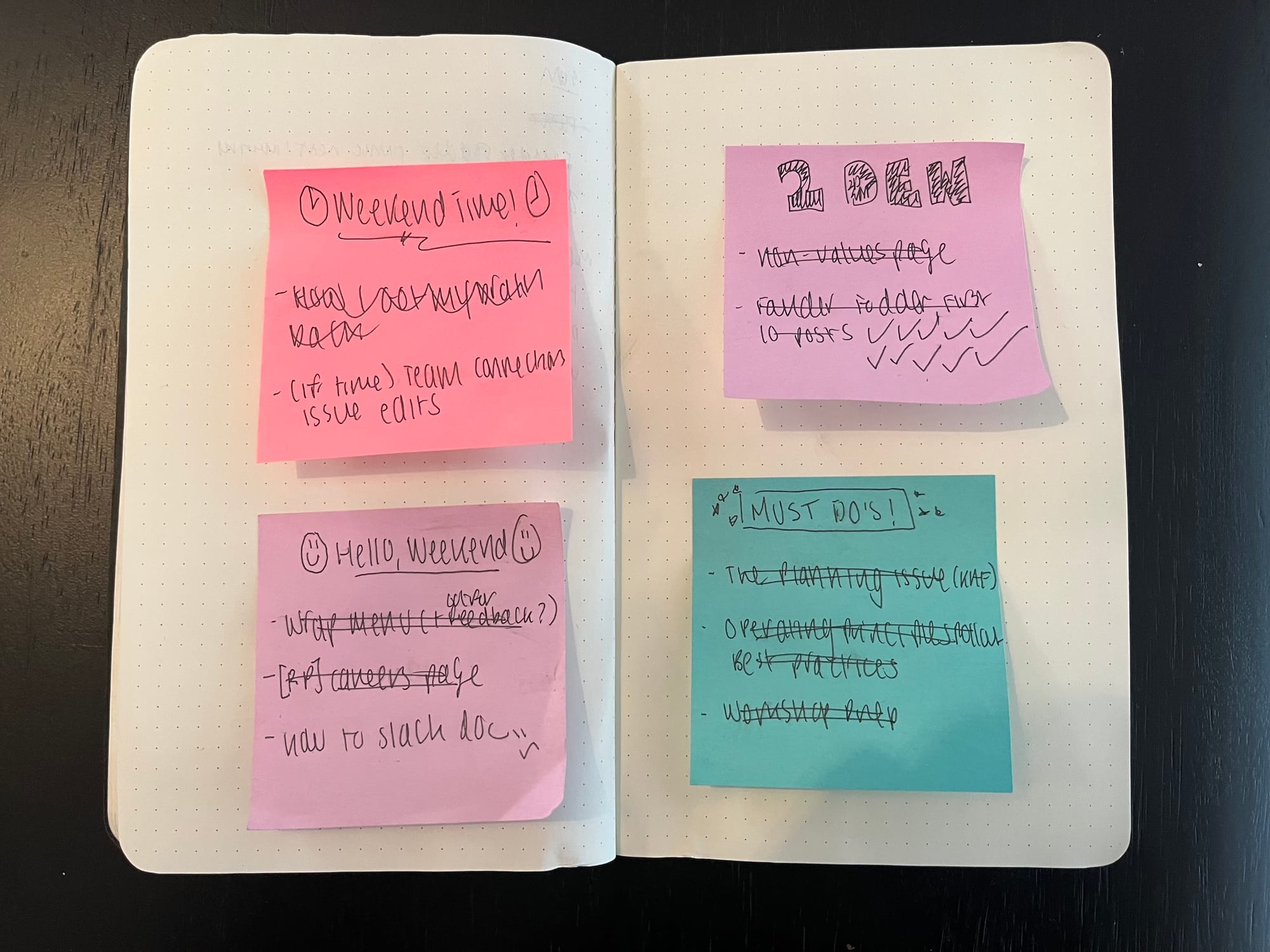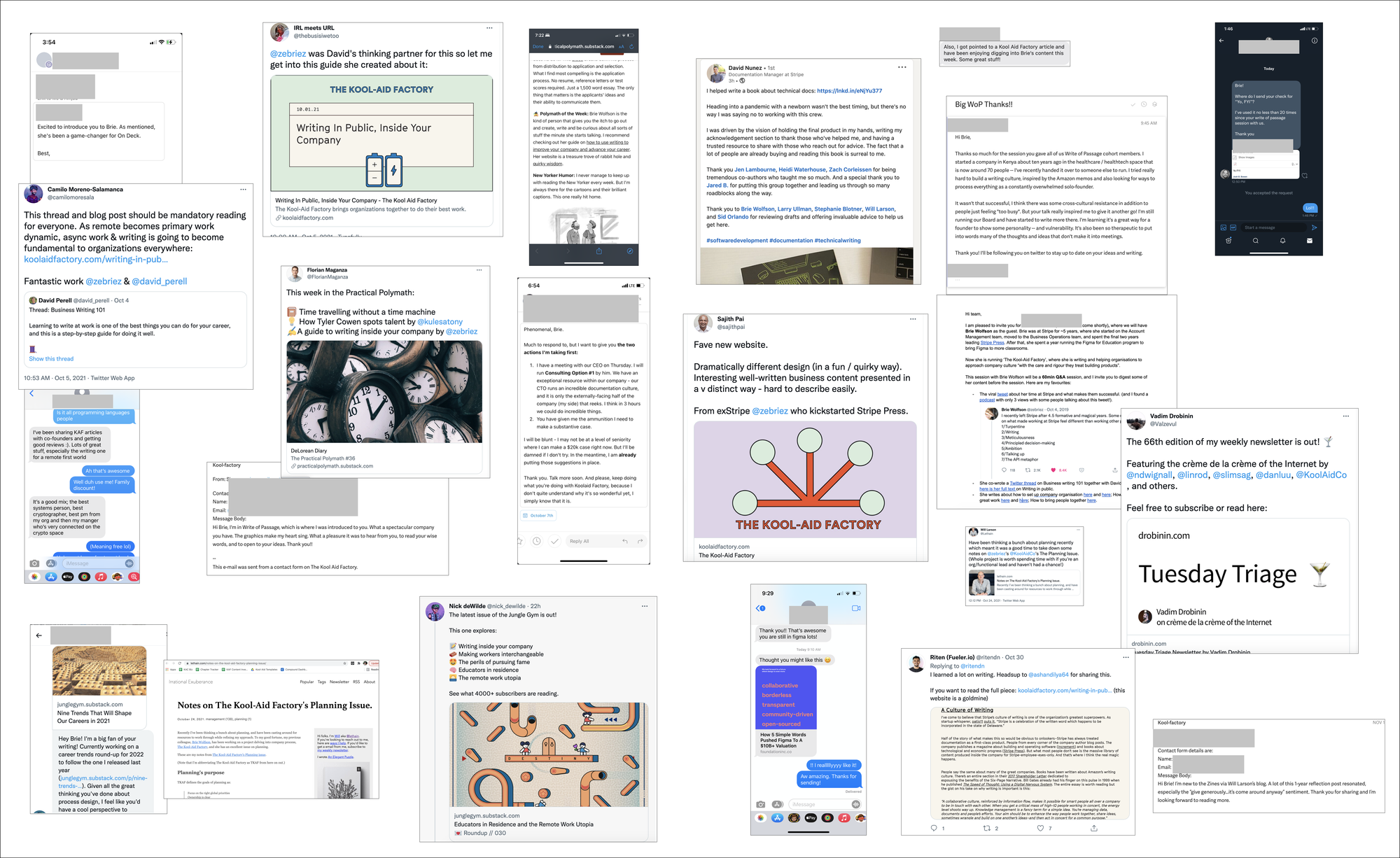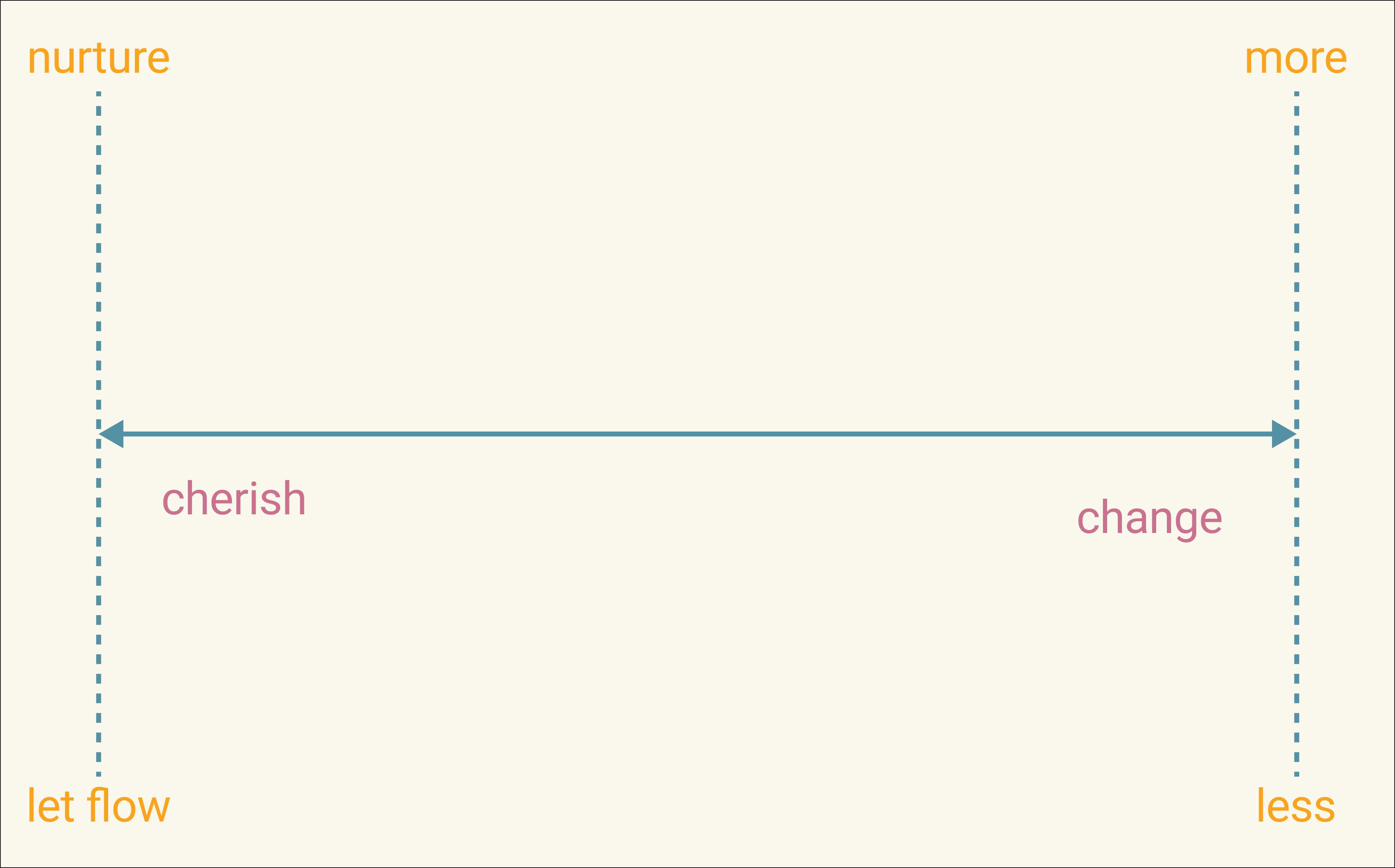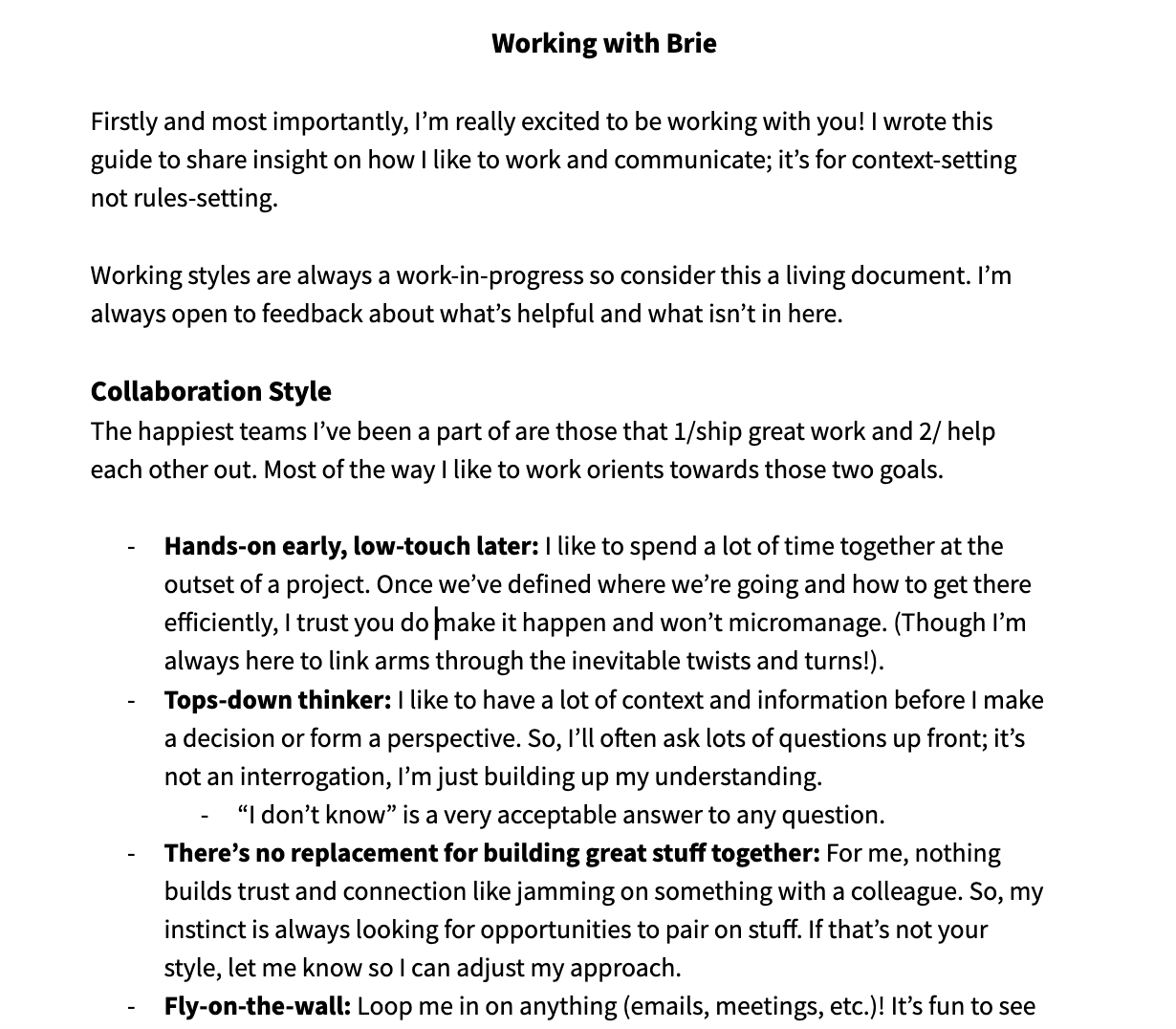This article is written by Brie Wolfson, who has worked for tech companies of all shapes and sizes, most recently Figma (Figma for Education) and Stripe (BizOps, Stripe Press). Now, she's working on The Kool-Aid Factory (part research project, part consultancy on the topic of company culture) and writing Founder Fodder, a newsletter about the quirks and quandaries facing startup founders.
Doing a great job in startup land requires taking ownership over your work no matter how many hats you’re wearing, plates you’re spinning, or balls you’re juggling…and no matter what corner or level of the organization you’re doing it from. That means picking the right stuff to focus on, and then working your tail off to get it done.
We all know that’s easier said than done. Those tantalizing unread counts on our Slack apps and inboxes are very good at grabbing our attention and pulling us into the reactive swirl where it’s all too easy to confuse motion for progress. And when we’re caught up in the daily realities of meetings, messages, emails, docs, asks from colleagues, reports, priorities, new priorities, tickets, decks, memos, and our personal lives (yes, that too), along with the emotional swings that come with riding the startup rollercoaster (yes, definitely that too!), it can be easy to succumb to the chaos and lose forest for the trees.
At the end of the day, though, the only thing that actually matters is the impact our work has on our company, our customers, our colleagues, and our professional development. And the only way to stay on top of that is to hold ourselves accountable to our higher-order goals with as much enthusiasm as we have for the dopamine rush of reaching inbox zero.
I can say from experience working at some fantastic organizations like Stripe and Figma, and with many others through my work on The Kool-Aid Factory, that the best leaders and operators I know are as good upholding the 30,000-foot perspective as they are getting the 3-inch-level work done. The tug-of-war between the two is real, but it’s manageable — with the right processes in place to help maintain focus.
So, here are the docs I’ve honed in on over the years that help me do that. Having this collection of personal templates in place helps me stay more focused, balanced, self-aware, context-aware, and in-control of my workflow on a daily basis. They’ve also helped me make real, sustained, progress towards my broader goals on that longer-term horizon. And I’m not only talking about internalizing and supporting my company’s goals. I’m talking about understanding and acting on my own career goals, too.
I’ve broken them down into categories to give you a better sense of which one to use when, along with some voiceover on how they all fit together. Throughout, I’ve included specific examples from my own career as well as template docs for you to copy and put your own spin on. As you’ll see, they are designed primarily for personal use, but I share bits and pieces with others if and when it makes sense.
I hope you try them and I hope they’re useful. Most of all, I hope they help you make more efficient progress towards your goals and make the experience of getting there more satisfying.

EVERYDAY DOCS
1. Ongoing Stack Rank (OSR)
An OSR is effectively a list of things I’m working on or could be working on over a given time period. An OSR is great for representing a global view of personal priorities and the ongoing status of each, and it’s the most tactically useful day-to-day.
There are three critical features of a good OSR:
- 1. Show outputs only. In this context, outputs are defined as shippable units work. Phrasing them as such will also help remind you that you can only check it off once it’s completed. For example, “hosted dinner for startups” can show up on your list, while “booked restaurant for startup dinner” shouldn’t. Inputs like this, of course, contribute and ladder up to your outputs, but you want to orient everything on your OSR towards outputs because that’s the stuff that’s ultimately going to drive your outcomes. If your work is only one piece of a cross-functional puzzle, you should still add your piece (especially if your piece would block the puzzle’s completion)!
- 2. Include workstream status: I’ll use a full spectrum of options from scoping, to in-progress, to ready to go, to shipped, to deprioritized for now (with dates). Showing what’s in-scope and above the priority line is often as helpful as showing what’s out-of-scope or below the priority line. It’ll also help you stay on top of the many, many workstreams you’re contributing to. Over time, this will turn into a list of things you’ve shipped.
- 3. Order by priority: This way, you can use the OSR as your guiding light for what you should be working on at any given moment in time. It also makes it really easy to pick your next workstream.
What you’ll produce will, in many ways, be an oversimplification of how work actually gets done — we all work on many, many things at once, each with their own set of dependencies and quirks. Things might move up and down on this list or get added to or removed from it. That’s okay! Record it all. This simplified list will provide clarity when things get especially messy and keep those higher-order goals top-of mind.
I also track many of those messy details in the OSR. For example, I might include dates, workstream size (I like t-shirt sizing, XS-XL), what company priority something ladders up to, or what broader workstream my work contributes to (and who own it), impact and success measurement criteria for each input (qualitative or quantitative), the audience or key stakeholders for my work (internal or external).
Here’s a template for what yours could look like (and a screenshot for a quick look):

Over the years, my OSR has helped me answer questions that previously confounded me like:
- How much work do I have in flight right now? Is it too much or too little?
- Am I getting stuff to completion or just inching an endless number of things forward?
- Am I owning a lot of work or contributing to the work others own?
- Should I say yes or no to this thing someone is requesting of me? If I’m saying no, how can I show others why?
- What flavors of work am I over or under-rotated on right now?
- How proactive vs. reactive is my work?
- Who am I blocking right now? Who’s blocking me?
- Who am I working with a lot lately?Is the work coming from me or them? Are there any patterns there?
- What company priority does this ladder up to? Uh oh, this doesn’t apparently ladder up to any company priority — should I even be working on it?
- What should I work on next?
If things are feeling especially chaotic or I haven’t marked anything completed in a while, I’ll also start a new column to track how much time something is taking every week and/or what’s preventing me from shipping or slowing things down so that I can paint a more data-driven picture of what’s going on.
It’s also been a great tool to use with my managers or stakeholders as a way to not only provide visibility into what I’m working on, but also to ensure we are aligned on priorities. I remember relying on my OSR during one particularly overwhelming period of work. Each Monday morning, my manager and I would open my OSR, look at what was in flight and what other teams were asking from me (including new requests coming in) and then order and re-order my OSR together. This way, I had a clear (and manager-approved) punch list of work.
Having clear direction for the week helped me stay calm and focused, when I think I otherwise might have felt more frantic and chaotic. It also helped my manager understand my bandwidth, speak intelligently to my priorities, and advocate for me accordingly. I’ve also relied on my OSR’s in periods of extraordinarily high or low work satisfaction to provide an objective account of what I’ve been working on.
2. “It’s Only The Weekend When” Post-It
Everyone’s got their own way to manage their to-do list, but one thing that has meaningfully changed the way I work and helped me actually prioritize the big stuff is to write down 3 (and no more than 3!) things I would be very disappointed to go into the weekend without completing. I like to put this on an actual post-it because it’s a nice Monday morning ritual and having this short list on a brightly-colored piece of actual paper makes it stand out from the other to-do lists, notifications, and trackers. Plus, it’s really satisfying to be able to cross it off when I finish something!
Throughout the week, I’ll move it around and stick it various places — in my notebook alongside my daily to-do list, on the cover of my notebook, in the corner of my monitor, at the bottom of the keyboard, or even on my bathroom mirror if I’m getting really desperate as the weekend nears!
If your OSR paints the overall picture of what’s in flight or could be soon, the weekend post-it tells you (more like screams at you!) what you should be doing right now.
If I think I’ll be crunched for time or my schedule isn’t looking particularly conducive to getting these things done, I’ll often block time to focus on them. I try not to do this too often, but I might even postpone lower-priority work or meetings to make the time if I really need it.
Here’s a picture of a few of mine from the last year:

3. “What I’m Proud Of” Scrapbook
This is exactly what it sounds like; a collection of things I’m proud of. It’s a running list and hodgepodge of formats (screenshots, emails, pings, feedback, etc.) with no real organizational structure, but over time, it will turn into a fantastic raw data set for the things that give you energy and make you tick. I dump things in this doc as they come. It’s much less structured than the OSR.
I’ve learned two very important things about myself through maintaining this doc over the years. The first is that the relationship to work I’ve shipped and work I’m proud of is not 1:1. Lining my Things I’m Proud of Scrapbook with my OSR side-by-side helps me figure out what work truly satisfies me. The second is that there are things I think I like doing, but never appear in this document. And, conversely, things I didn’t think I cared about, but really, really do.
For example, I thought I might want a career with an analytics focus. Turns out, not a single one of my analyses ended up in the “What I’m proud of” scrapbook. And, others weren’t giving me any shining feedback on my contributions. Conversely, I didn’t think that I was motivated by direct, positive feedback (and rather through hole-poking). But, screenshots of kind pings from colleagues and happy recipients of my work end up filling my doc.
My scrapbook of things I’m proud of tests the stories I tell myself about what I care about by matching them to reality.
It helps me move through my career with true data and insight into what makes me happy and, therefore, what I want to do more of. Here’s a snapshot from a page in mine:

4. Snag Log
A snag log has similar properties of the Scrapbook of Things I’m Proud Of, but the snag log covers the things that bogged me down instead of the things that lifted me up. Or, as a colleague once phrased it, “the things that give me the ickies.” You know what these things are — the things that made your tummy turn or maybe made you want to throw your laptop out the window or scream into a pillow.
Be honest with yourself when this happens. And, the degree of the “ickies” you got when you got them! Things that have appeared in my “ickies” list include: “still can’t get this query to run (10!!)” and “weekly standup bores me to tears,” and “welp, that launch was totally lackluster. Waste of time?” It might feel embarrassing or silly at the moment it’s happening, but it’s data you can use to get more productive or find more joy in your work.
Filling out this document reminds me of a ritual my college soccer team practiced — if you made a mistake or a bad play, you’d pull up a few blades of grass and then toss them into the wind. In the work environment, maintaining this document provides me with a more productive outlet to express my annoyance, frustration, or disappointment. Getting those big feelings out of my head and into a document has helped reduce some in-the-moment anxiety and made me a lot less likely to inadvertently spread any of my negativity to others — in my work and professional life, alike.
More broadly, this document has helped me identify broader patterns in my attitude towards work. One very helpful learning is that I am quite sensitive — lots of things feel like little snags at the time. One related and refreshing learning is that I have a short memory for these snags. Whew! Many times when I read this document back, I barely remember the incident.
On the flip side, this document has also helped me recognize and get ahead of paper cuts that are starting to fester into bigger, more painful, wounds. Sometimes, I’ll see the same name or the same flavor of work pop up over and over again. That’s a good time to intervene or switch things up in some way. Sometimes that means enlisting the support of someone else to help you do that, and if that’s the case, you’ll have plenty of examples at the ready so you can find the right path forward.
5. “Today, I Learned”
This document is also relatively straightforward. It’s a list of things I learned, usually in bullet form. Learnings, for me, range from technical details (“the API works this particular way”), to storing things that I might want to find later (“use this query when you want to calculate that”, “link to support’s canned responses”), to observations about working styles (“Alice is sharper in the morning (self-proclaimed)”, “Doris reads emails closely, even if she doesn’t respond,”), to personal details I want to remember about colleagues (“Deep has a 3-year-old son named Leo”), to personal insights (“Jordan gave me feedback that I’m usually the most optimistic voice in the room”, “appear to be slower than colleagues at learning SQL”). Date them or batch them by month so you can look back and understand the timing and context.
I find myself returning to this document and searching in it all the time. I find that I often remember that I put something related to the thing in the doc, but can’t remember the details around it. Having this doc helps me return to them with just a few seconds of searching.
It’s useful in my day-to-day work because it makes me a lot less likely to ask the same question twice, and helps me unblock myself instead of relying on others. I’ve also found that I’m more likely to remember something if I take the ten seconds required to add it to the list. (And, the research is with me on this one — re-writing something helps our brains encode the information. It also says that writing is better than typing it, but that would make the doc less searchable which, for me, is more important).
When it comes to self-reflection, this document has helped me get a more nuanced perspective on what and how I’m learning, as well as the slope and rate of that learning. For example, I’ve found that there are periods that may be low-learning on technical topics, but might be high-learning in organizational or team dynamics.
A lot of career advice circles around the idea of “leave when you stop learning.” I think that’s directionally good advice — so long as you have an open mind about what learning looks like.
Having a document can help you understand, with relatively high-fidelity, where you are in your learning journey. And form there, whether you want something to change as a result.
MONTHLY DOCS
6. Impact Tracking (in your OSR)
Using your OSR as your guide, take a look at all the things you shipped and jot down some notes about their impact. Do your best to focus on observable outcomes — what metrics moved, how metrics moved, what users said or did as a result, what colleagues said or did as a result, etc.
This will not only come in handy during performance review season, but it will also start to train and tune your model about what work actually generates impact. And, it will help you speak intelligently about that with others (especially when they come knocking on your door asking for your help with something).
7. Me-Sat
Many of us will be familiar with C-Sat, short for customer satisfaction, as a metric for how satisfied customers are with a product or service. Many of us will also have filled out a company satisfaction survey (also known as an employee voice survey) that contributes to a broad company satisfaction score and accompanying read-out about how satisfied employees are with their companies. I say it’s time we all get in the habit of turning this question on ourselves, and evaluating our own satisfaction, or “Me-sat.”
There are lots of ways to take your own pulse, and I’ll share some of my favorite examples and exercises below. No matter which exercise you go with, the most impactful things for me have been getting in the habit of taking some time and space for self-reflection (i.e. actually doing one of these exercises with some regularity) and looking backwards to identify patterns in a way that helps inform future behavior.
- Satisfaction Litmus Test: A simple structure for a check-in, taken from my favorite planner, designed (and sold!) by David Singleton, Stripe’s Head of Engineering. All this exercise requires is that you score yourself between 1-4 on four core drivers of satisfaction: enjoyed it, got stuff done, progressed goals, learning. Average them together (or use a weighted average if you’re feeling extra thorough), to generate an overall “Me Sat.”
- Blood Kool-Aid Content: One way to describe “Me Sat” can also be your current Blood Kool-Aid Content. As in, how much of the company’s Kool-Aid do I have pulsing through my veins? Or, how into the company’s mission, leadership, coworkers, role, and operating norms am I at a given moment? This single-prong score can be susceptible to bias by your current mood, but it never hurts to track it. (Or, ask yourself where you’re at on this scale when you’re feeling extra charged up about something as a way to build more self-awareness and take more measured action).
- Contribute to Your “Four Lists”: This one’s coined by Molly Graham (Google, Facebook, Quip, Lambda School, Chan Zuckerberg) and suggests you contribute to four lists; things I love doing, things I’m exceptional at, things I hate doing, things I’m bad at. I like to use these as running lists as opposed to making a new one every month. Take note of what changes — maybe even track them in a changelog.
- Energy Assessment: Similar to Molly’s four lists, and introduced to me by Stephanie Zou (Zendesk, Figma) this exercise helps you articulate how the things you work on impact your energy, and what you would like more and less exposure to over time.
- Stop, Start, Continue Retrospective: This classic retrospective framework asks you to consider what you want to start, stop, and continue doing. It’s often used to reflect on collaborative or cross functional work, but there’s no reason you can’t use it for yourself! Here’s a template if you want to try it yourself.
- Cherish / Change Retrospective: Another retrospective framework I’ve been playing around with is the Change / Cherish Scale. On one side of the spectrum, I have things I want to hold on to. From there, I ask myself if I want or need to nurture this thing (as in, focus some attention on gardening/watering it) or let it flow (as in, don’t intervene and let things happen.) On the other side are the things I want to change. From there, I’ll ask myself if I want more of it or less of it. Here’s a template if you want to give this one a try.

I’ve used each of these exercises at varying points. In fact, I like to switch up the framework for my reflections to keep them fresh. Ultimately, they all answer the same questions — what things should I lean into at work? Your daily docs can help inform all of these, and building a regular practice of putting all the pieces together, through targeted self-reflection, will also help you hone in on the story you tell about yourself about where you’re at and where you want to go (with real examples!) to others who can help you along the way.
QUARTERLY DOCS
8. Personal Press Release
Imagine you are writing a press release about all the things you shipped and the impact they are having. You’ll likely want to rely heavily on your OSR (including impact) and maybe include a sprinkling of details from your Scrapbook of Things I’m Proud Of, Today I Learned, and Snag Log docs.
Some things you might want to include in your press release are:
- Headline/Lede: the attention grabber
- One-line summary: imagine how someone would describe this to a colleague
- Top 3-5 things you shipped
- Where your time went
- Key insights or learnings
- Progress on metrics
- Qualitative impacts
- Contributions to the broader team/company
- Feedback you received from stakeholders/users (internal or external)
- One piece of art (graph, picture, screenshot, etc.)
- Overall mood/sentiment
- Anything the broader organization did that you wish you could have been a part of
- What you’re really proud of
- Anything you’re not so proud of
- A look ahead on: What you’re shipping next, what you’re excited about, big opportunities for you, your team, or your company, and any foreseen blockers, risks, or things that you’re worried about.
Here they are in a template so you can get to work on your own press release faster. I like to do these on a weekend or evening when things are a bit quieter and I can give it my full focus. I also time-box these to 3 hours max so I don’t get too carried away.
Do yourself a favor and write this in prose. You don’t have to show anyone, but it’ll be exceedingly cool to look back at the catalog of these over time, and you’ll be more likely to do that if they’ve got a bit of a punch to them. When you do, you’ll inevitably get to say to yourself, “dang, I really did all that?!” And that’s the kind of feeling that keeps you going through all the vicissitudes of startup life.
It’s worth acknowledging that companies will often prompt some version of this for performance review purposes, but I think it’s worth doing one without the perf pressure-cooker timer ticking, for your eyes only, that covers not only your impact, but also how satisfied you are.
ANNUAL DOCS
9. Job Description
The best and worst thing about working at dynamic companies is that everything is always changing — the landscape, the product roadmap, what users want, your team composition, your manager. That means, what the company needs from you is always changing, which means your job is always changing. Because you are living it every day, it can be hard to detect even very material changes in your role and responsibilities over time.
It’s like aging — hard to detect on the day-to-day scale, easy to detect on the decade scale, and fuzzy-ish in between. To help me get more crisp on how things are changing, I re-write my own job description every six months.
A typical job description has three components and you can use these same components when you craft yours:
- 1. overall description of the relationship between the role and the broader company and its goals (usually 1-2 paragraphs of prose)
- 2. list of responsibilities (usually bullets), and
- 3. skills that are required to do a great job.
I’ve found that 1 often remains relatively stable, 2 changes all the time, and 3 evolves steadily. Ideally, the responsibilities trend increasingly strategic and interesting to you over time and that 2 never outpaces 3.
When you put pen to paper on yours, I would suggest that the first paragraph has a very memorable one-liner mission statement. Think about what you would want your manager to say if someone asked her, “what is $NAME working on these days?” Why? Because they probably do! And, you should probably have some language that you can consistently use to talk about your role with others.
Here’s a template you can use to construct yours.
If you see meaningful changes version to version, it’s probably a good idea to check in with your manager. Depending on how you are feeling about your role and responsibilities, you can use this to gut-check and guide a conversation on your areas of focus with your manager.
Another thing I’ve been experimenting with is creating an aspirational job description for ~1-2 years out. This creates a clear, tangible articulation of where you want to go in the future. What you write doesn’t have to have any conception of your current skills or what the company needs. It’s all about you and where you want to go. You may find that this role exists, and that you can have it!
A few years ago, a few colleagues and I got together on a Saturday afternoon and wrote them. It was a pretty fun exercise — especially because it combined our hopes and dreams for our own careers along with the strategic direction or best we wanted our company to take.
10. Working with Me
Jay Desai first conceived of this concept (though he called it a ‘user guide’) and I first learned about it when I read Claire Hughes Johnson’s, former COO of Stripe. It’s a way to express and scale your preferred working style and preferences.
For leaders creating one, be conscious of the implicit power dynamics at play — specifically, whether you are expecting those who work with you to adapt their working style to yours to accommodate your preferences. For individual contributors, I’ve found that this document is a really helpful form of self-expression that leads to better, healthier, more efficient working relationships. When done well, they also show a great deal of self-awareness that help colleagues understand each other a lot better.
I’ve also leaned on ‘working with me’ documents in situations when something’s not quite clicking with a colleague and you’re not sure why. Creating and then comparing documents has been immensely helpful in spotting unexpected points of alignment or misalignment that can lead to moments of deeper connection and teasing out root causes of work friction.
I also like to maintain a changelog at the bottom of the doc. The rate of change will likely decrease over the course of your career. If you feel like your style or preferences are evolving enough to change this canonical doc on how you like to work, it’s important you register this with yourself and anyone else who works closely with you formally. (They’ve probably noticed anyway, and it’s a good opportunity to talk about that evolution and learn more about it and its impact on others).
Here’s a link to mine! And a preview screenshot:

PUTTING IT ALL INTO PRACTICE
If you’d like to try incorporating these into your workflow, here’s a calendar you can subscribe to that’ll keep them top-of mind. It’s the same one I’ve been using for years, and I’m excited to bring even more people along in the process of self-reflection, personal development, and greater organizational awareness.
It takes a bit of a mental shift and some discipline to work this way, but it’s worth it. Even when worklife is feeling its most chaotic, there are clues hiding in plain sight and patterns waiting to reveal themselves. Because when we do what it takes to uncover them, the work we produce gets a whole lot better and the journey feels a lot more rewarding.
And, we don’t have to wait for anyone else to help get us there. We can take it all into our own hands!
